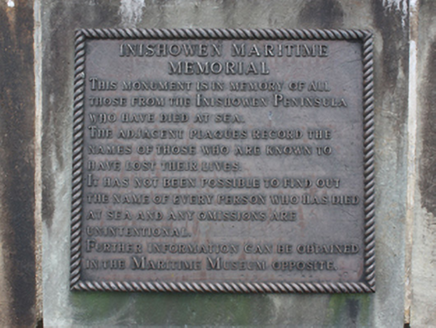Survey Data
Reg No
40810010
Rating
Regional
Categories of Special Interest
Artistic, Social
Original Use
Monument
In Use As
Monument
Date
1995 - 2000
Coordinates
264640, 439997
Date Recorded
18/09/2008
Date Updated
--/--/--
Description
Memorial commemorating those from the Inishowen Peninsula who lost their lives at sea from 1771 on, erected 1997, comprising an ornamental bronze armillary sphere\astrolabe set on random rubble plinth (on circular-plan) with concrete top. Monument surrounded by coursed random rubble stone walls having smooth rendered coping over, and with bronze memorial plaques listing names of individuals lost at sea. Paved with limestone slabs having Celtic cross motif, and with water-rolled pebbles. Located adjacent to the piers at Greencastle Harbour, and adjacent to the south-east of Inishowen Maritime Museum (see 40810012).
Appraisal
This solemn memorial was erected in 1997 to commemorate those from the Inishowen Peninsula who lost their lives at sea from 1771 onwards. The armillary sphere or astrolabe that forms the centrepiece of the memorial is well-crafted and is a work of some artistic and aesthetic merit. The circular boundary wall surrounding the monument has bronze plaques listing the names of those who lost their lives at sea; including the c. 100 individuals who were lost in a devastating storm in 1771, and the c. 30 who lost their lives in another storm in 1831. This memorial marks the difficult history of this seafaring community of Inishowen, and is of social interest. The verse on the plinth reads ‘There are no roses on a sailor's grave, No lilies on an ocean wave, The only tribute is the seagull's sweep, And the tear drops that a loved one weeps’. The architect for the project was Caroline Dickson, the consultant for the armillary sphere design was Owen Deignan, and it was constructed by Doherty Engineering. The surrounding walls and the garden were built by FÁS apprentices and trainees. The memorial was unveiled on the 6th of June 1997 by the then President, Mary Robinson. It forms a pair of related structures along with the Inishowen Maritime Museum (see 40810012) adjacent to the north.













